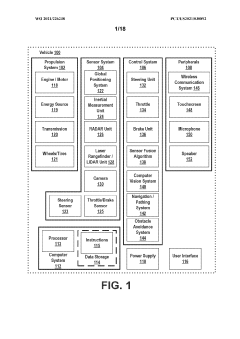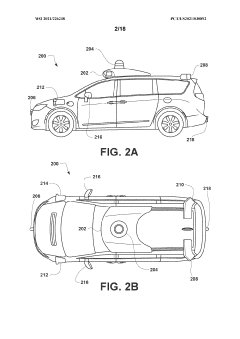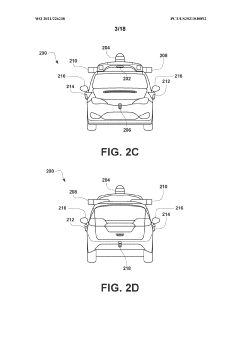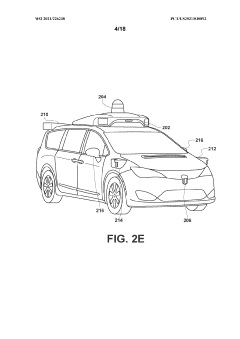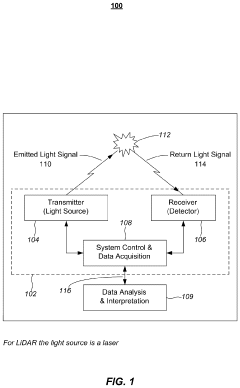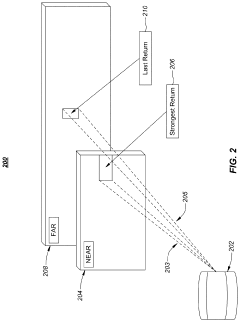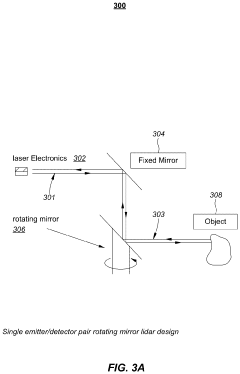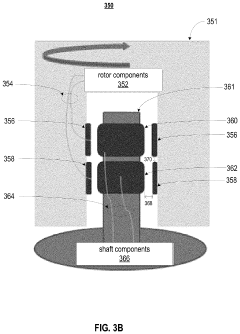Reducing Cross-Talk In Multi-Beam Metasurface LiDAR Systems
SEP 1, 202510 MIN READ
Generate Your Research Report Instantly with AI Agent
Patsnap Eureka helps you evaluate technical feasibility & market potential.
Metasurface LiDAR Cross-Talk Challenges and Objectives
Metasurface LiDAR technology represents a significant advancement in the field of light detection and ranging systems, offering enhanced capabilities for 3D sensing, autonomous navigation, and environmental mapping. The evolution of this technology has been marked by a transition from traditional mechanical LiDAR systems to solid-state solutions, with metasurfaces emerging as a promising approach for beam steering and manipulation.
Cross-talk, the undesired interference between adjacent optical channels or beams, has become a critical challenge as multi-beam metasurface LiDAR systems increase in complexity and beam density. This phenomenon occurs when light from one beam path leaks into neighboring detection channels, resulting in signal degradation, false positives, and reduced ranging accuracy. The severity of this issue has grown proportionally with the industry's push toward higher resolution and longer detection ranges.
The technical evolution trajectory shows a clear trend toward miniaturization and integration, with metasurfaces offering unprecedented control over light propagation at the subwavelength scale. These artificially engineered surfaces, composed of nanoscale structures, can manipulate electromagnetic waves in ways conventional optics cannot, enabling novel beam steering mechanisms without moving parts. However, as beam density increases, the fundamental physics of diffraction and near-field coupling presents escalating challenges for cross-talk mitigation.
Current research indicates that cross-talk in metasurface LiDAR systems stems from multiple sources: diffraction effects at the metasurface interface, scattering from imperfections in fabrication, multiple reflections within the optical system, and environmental factors such as atmospheric scattering. Each of these mechanisms requires distinct mitigation strategies, making comprehensive solutions particularly challenging.
The primary technical objective in this domain is to develop robust methods for reducing cross-talk while maintaining or improving other critical performance parameters such as detection range, angular resolution, and power efficiency. Specific goals include achieving cross-talk suppression of at least 30dB between adjacent channels, maintaining this performance across varying environmental conditions, and implementing solutions that remain compatible with mass manufacturing processes.
Secondary objectives include developing adaptive systems capable of real-time cross-talk compensation, establishing standardized testing methodologies to quantify cross-talk in complex multi-beam systems, and creating simulation frameworks that accurately predict cross-talk behavior during the design phase. These capabilities would significantly reduce development cycles and enable more rapid innovation in the field.
The broader impact of solving these challenges extends beyond immediate performance improvements. Effective cross-talk reduction would enable higher beam densities, leading to LiDAR systems with superior resolution and range. This advancement would directly benefit applications in autonomous vehicles, robotics, industrial automation, and augmented reality, where precise 3D sensing is critical for safe and effective operation.
Cross-talk, the undesired interference between adjacent optical channels or beams, has become a critical challenge as multi-beam metasurface LiDAR systems increase in complexity and beam density. This phenomenon occurs when light from one beam path leaks into neighboring detection channels, resulting in signal degradation, false positives, and reduced ranging accuracy. The severity of this issue has grown proportionally with the industry's push toward higher resolution and longer detection ranges.
The technical evolution trajectory shows a clear trend toward miniaturization and integration, with metasurfaces offering unprecedented control over light propagation at the subwavelength scale. These artificially engineered surfaces, composed of nanoscale structures, can manipulate electromagnetic waves in ways conventional optics cannot, enabling novel beam steering mechanisms without moving parts. However, as beam density increases, the fundamental physics of diffraction and near-field coupling presents escalating challenges for cross-talk mitigation.
Current research indicates that cross-talk in metasurface LiDAR systems stems from multiple sources: diffraction effects at the metasurface interface, scattering from imperfections in fabrication, multiple reflections within the optical system, and environmental factors such as atmospheric scattering. Each of these mechanisms requires distinct mitigation strategies, making comprehensive solutions particularly challenging.
The primary technical objective in this domain is to develop robust methods for reducing cross-talk while maintaining or improving other critical performance parameters such as detection range, angular resolution, and power efficiency. Specific goals include achieving cross-talk suppression of at least 30dB between adjacent channels, maintaining this performance across varying environmental conditions, and implementing solutions that remain compatible with mass manufacturing processes.
Secondary objectives include developing adaptive systems capable of real-time cross-talk compensation, establishing standardized testing methodologies to quantify cross-talk in complex multi-beam systems, and creating simulation frameworks that accurately predict cross-talk behavior during the design phase. These capabilities would significantly reduce development cycles and enable more rapid innovation in the field.
The broader impact of solving these challenges extends beyond immediate performance improvements. Effective cross-talk reduction would enable higher beam densities, leading to LiDAR systems with superior resolution and range. This advancement would directly benefit applications in autonomous vehicles, robotics, industrial automation, and augmented reality, where precise 3D sensing is critical for safe and effective operation.
Market Analysis for Advanced LiDAR Systems
The global LiDAR market is experiencing robust growth, projected to reach $3.8 billion by 2025 with a CAGR of 34.0% from 2020. This expansion is primarily driven by increasing adoption in autonomous vehicles, advanced driver-assistance systems (ADAS), and industrial automation applications. Multi-beam metasurface LiDAR systems represent a cutting-edge segment within this market, offering advantages in size, weight, power consumption, and potentially cost compared to traditional mechanical and solid-state LiDAR technologies.
The automotive sector remains the largest market for advanced LiDAR systems, accounting for approximately 55% of total market share. Major automotive manufacturers and technology companies are investing heavily in LiDAR technology to enable Level 3-5 autonomous driving capabilities. The reduction of cross-talk in multi-beam systems is particularly critical for this application, as it directly impacts detection accuracy and reliability in complex traffic environments.
Beyond automotive applications, industrial automation represents the second-largest market segment at 20% of the total LiDAR market. Warehouse robotics, manufacturing quality control, and logistics automation all benefit from high-precision LiDAR systems with minimal interference between multiple beams. The ability to deploy multiple LiDAR units in close proximity without cross-talk issues presents a significant competitive advantage in these densely automated environments.
Consumer electronics applications are emerging as a rapidly growing segment, particularly for mobile devices, augmented reality, and smart home systems. This market is highly sensitive to size and cost constraints, making metasurface-based solutions particularly attractive if cross-talk issues can be effectively addressed.
Regional analysis indicates North America leads the advanced LiDAR market with 40% share, followed by Europe (30%) and Asia-Pacific (25%). However, Asia-Pacific is expected to demonstrate the highest growth rate over the next five years, driven by rapid industrialization and automotive manufacturing expansion in China, Japan, and South Korea.
Customer requirements analysis reveals that cross-talk reduction is among the top three technical priorities for LiDAR system buyers, alongside cost reduction and increased resolution. Survey data indicates that 78% of potential customers consider cross-talk performance a critical factor in purchasing decisions for multi-beam LiDAR systems.
Pricing sensitivity analysis suggests that effective cross-talk reduction technology could command a 15-20% premium in the market, particularly for safety-critical applications where signal integrity is paramount. This represents a significant value-creation opportunity for companies that can effectively solve this technical challenge.
Market barriers include high initial development costs, complex integration requirements, and competition from alternative sensing technologies such as radar and camera-based systems. However, the unique capabilities of multi-beam metasurface LiDAR systems with reduced cross-talk could establish a defensible market position against these alternatives.
The automotive sector remains the largest market for advanced LiDAR systems, accounting for approximately 55% of total market share. Major automotive manufacturers and technology companies are investing heavily in LiDAR technology to enable Level 3-5 autonomous driving capabilities. The reduction of cross-talk in multi-beam systems is particularly critical for this application, as it directly impacts detection accuracy and reliability in complex traffic environments.
Beyond automotive applications, industrial automation represents the second-largest market segment at 20% of the total LiDAR market. Warehouse robotics, manufacturing quality control, and logistics automation all benefit from high-precision LiDAR systems with minimal interference between multiple beams. The ability to deploy multiple LiDAR units in close proximity without cross-talk issues presents a significant competitive advantage in these densely automated environments.
Consumer electronics applications are emerging as a rapidly growing segment, particularly for mobile devices, augmented reality, and smart home systems. This market is highly sensitive to size and cost constraints, making metasurface-based solutions particularly attractive if cross-talk issues can be effectively addressed.
Regional analysis indicates North America leads the advanced LiDAR market with 40% share, followed by Europe (30%) and Asia-Pacific (25%). However, Asia-Pacific is expected to demonstrate the highest growth rate over the next five years, driven by rapid industrialization and automotive manufacturing expansion in China, Japan, and South Korea.
Customer requirements analysis reveals that cross-talk reduction is among the top three technical priorities for LiDAR system buyers, alongside cost reduction and increased resolution. Survey data indicates that 78% of potential customers consider cross-talk performance a critical factor in purchasing decisions for multi-beam LiDAR systems.
Pricing sensitivity analysis suggests that effective cross-talk reduction technology could command a 15-20% premium in the market, particularly for safety-critical applications where signal integrity is paramount. This represents a significant value-creation opportunity for companies that can effectively solve this technical challenge.
Market barriers include high initial development costs, complex integration requirements, and competition from alternative sensing technologies such as radar and camera-based systems. However, the unique capabilities of multi-beam metasurface LiDAR systems with reduced cross-talk could establish a defensible market position against these alternatives.
Current Limitations in Multi-Beam Metasurface LiDAR
Despite significant advancements in multi-beam metasurface LiDAR technology, several critical limitations continue to impede optimal performance. Cross-talk between adjacent beams represents one of the most significant challenges, occurring when light from one beam scatters into the detection path of neighboring beams. This phenomenon creates false signals and reduces the signal-to-noise ratio, ultimately compromising the accuracy and reliability of distance measurements.
The current metasurface designs exhibit inherent limitations in beam isolation capabilities. Most existing architectures struggle to maintain adequate spatial separation between beams when operating at high beam densities, leading to increased cross-talk at system boundaries. This issue becomes particularly pronounced in environments with highly reflective or particulate-rich atmospheres, where scattered light compounds the problem.
Temporal synchronization presents another substantial hurdle. Current systems often employ time-division multiplexing to mitigate cross-talk, but this approach significantly reduces the effective frame rate and overall system responsiveness. The trade-off between temporal resolution and cross-talk suppression forces compromises in real-time applications such as autonomous navigation.
Power efficiency constraints further exacerbate cross-talk issues. To overcome environmental noise and achieve adequate signal strength, beam power must be increased, which inadvertently amplifies cross-talk effects. The current generation of metasurface LiDAR systems lacks sophisticated power management capabilities that can dynamically adjust beam characteristics based on environmental conditions.
Material limitations in metasurface fabrication also contribute to cross-talk problems. Current manufacturing processes struggle to produce metasurfaces with perfectly uniform optical properties across their entire surface, resulting in unpredictable beam behavior and increased stray light. The precision required for optimal beam formation exceeds what is consistently achievable with current fabrication techniques.
Detection electronics represent another bottleneck. The photodetectors and signal processing circuits in current systems have limited dynamic range, making them susceptible to saturation from strong reflections while simultaneously struggling to detect weak return signals. This imbalance creates detection blind spots and increases vulnerability to cross-talk interference.
Environmental factors further compound these limitations. Temperature fluctuations cause thermal expansion in metasurface components, altering beam characteristics and increasing cross-talk probability. Current systems lack effective thermal compensation mechanisms, resulting in performance degradation under varying environmental conditions.
Integration challenges with other vehicle systems also present significant hurdles. Electromagnetic interference from adjacent electronic systems can induce noise in LiDAR detection circuits, further reducing the signal-to-noise ratio and making cross-talk effects more pronounced. Current shielding approaches add substantial weight and complexity without fully resolving the issue.
The current metasurface designs exhibit inherent limitations in beam isolation capabilities. Most existing architectures struggle to maintain adequate spatial separation between beams when operating at high beam densities, leading to increased cross-talk at system boundaries. This issue becomes particularly pronounced in environments with highly reflective or particulate-rich atmospheres, where scattered light compounds the problem.
Temporal synchronization presents another substantial hurdle. Current systems often employ time-division multiplexing to mitigate cross-talk, but this approach significantly reduces the effective frame rate and overall system responsiveness. The trade-off between temporal resolution and cross-talk suppression forces compromises in real-time applications such as autonomous navigation.
Power efficiency constraints further exacerbate cross-talk issues. To overcome environmental noise and achieve adequate signal strength, beam power must be increased, which inadvertently amplifies cross-talk effects. The current generation of metasurface LiDAR systems lacks sophisticated power management capabilities that can dynamically adjust beam characteristics based on environmental conditions.
Material limitations in metasurface fabrication also contribute to cross-talk problems. Current manufacturing processes struggle to produce metasurfaces with perfectly uniform optical properties across their entire surface, resulting in unpredictable beam behavior and increased stray light. The precision required for optimal beam formation exceeds what is consistently achievable with current fabrication techniques.
Detection electronics represent another bottleneck. The photodetectors and signal processing circuits in current systems have limited dynamic range, making them susceptible to saturation from strong reflections while simultaneously struggling to detect weak return signals. This imbalance creates detection blind spots and increases vulnerability to cross-talk interference.
Environmental factors further compound these limitations. Temperature fluctuations cause thermal expansion in metasurface components, altering beam characteristics and increasing cross-talk probability. Current systems lack effective thermal compensation mechanisms, resulting in performance degradation under varying environmental conditions.
Integration challenges with other vehicle systems also present significant hurdles. Electromagnetic interference from adjacent electronic systems can induce noise in LiDAR detection circuits, further reducing the signal-to-noise ratio and making cross-talk effects more pronounced. Current shielding approaches add substantial weight and complexity without fully resolving the issue.
Existing Cross-Talk Reduction Solutions
01 Metasurface beam steering techniques for LiDAR
Metasurfaces can be used in LiDAR systems to enable precise beam steering and manipulation. These optical structures can generate multiple beams with controlled directionality, which helps in reducing cross-talk between adjacent beams. By engineering the phase profile of the metasurface, the beam patterns can be optimized to minimize interference while maintaining high spatial resolution for LiDAR applications.- Metasurface-based beam steering for LiDAR: Metasurfaces can be used in LiDAR systems to enable precise beam steering and manipulation. These nanostructured optical components can control the phase, amplitude, and polarization of light, allowing for efficient beam formation and direction. By incorporating metasurfaces into LiDAR systems, multiple beams can be generated and steered independently, which helps in reducing cross-talk between channels while maintaining compact system design.
- Cross-talk reduction techniques in multi-beam LiDAR: Various techniques can be employed to reduce cross-talk in multi-beam LiDAR systems. These include temporal separation (time-division multiplexing), frequency separation (wavelength division multiplexing), spatial separation, and coding schemes. By implementing these techniques, interference between adjacent beams can be minimized, leading to improved signal quality and more accurate distance measurements in multi-beam metasurface LiDAR systems.
- Signal processing algorithms for cross-talk mitigation: Advanced signal processing algorithms can be implemented to mitigate cross-talk effects in multi-beam metasurface LiDAR systems. These algorithms can identify and filter out interference patterns, distinguish between genuine return signals and cross-talk artifacts, and apply correction factors to improve measurement accuracy. Machine learning approaches can also be employed to adaptively recognize and compensate for cross-talk under varying environmental conditions.
- Optical isolation techniques for multi-beam systems: Optical isolation techniques can be implemented in multi-beam metasurface LiDAR systems to prevent unwanted interactions between beams. These techniques include polarization-based isolation, spatial filtering, optical circulators, and specialized coatings. By incorporating these isolation methods, cross-talk between transmit and receive paths can be significantly reduced, improving the overall performance and reliability of the LiDAR system.
- System architecture optimization for cross-talk reduction: Optimizing the overall system architecture of multi-beam metasurface LiDAR can significantly reduce cross-talk issues. This includes careful placement of optical components, strategic arrangement of beam patterns, integration of beam forming networks, and implementation of modular designs that physically separate critical components. By considering cross-talk reduction at the system architecture level, more robust and reliable multi-beam LiDAR systems can be developed for various applications.
02 Cross-talk reduction through signal processing algorithms
Advanced signal processing algorithms can be implemented to mitigate cross-talk in multi-beam LiDAR systems. These algorithms can distinguish between intended return signals and interference from adjacent beams by analyzing temporal and spatial characteristics of the received signals. Techniques such as frequency modulation, time-division multiplexing, and adaptive filtering help in isolating the desired signal from cross-talk noise, thereby improving the overall performance of metasurface-based LiDAR systems.Expand Specific Solutions03 Optical isolation techniques for multi-beam systems
Various optical isolation techniques can be employed to reduce cross-talk in multi-beam metasurface LiDAR systems. These include the use of polarization filters, spatial filters, and specialized optical coatings that selectively transmit or reflect specific wavelengths. By physically separating the optical paths of different beams or by using orthogonal polarization states, the interference between adjacent channels can be significantly reduced, leading to cleaner signal detection.Expand Specific Solutions04 Wavelength division multiplexing for cross-talk mitigation
Wavelength division multiplexing (WDM) can be implemented in metasurface LiDAR systems to reduce cross-talk between multiple beams. By assigning different wavelengths to different beams, the system can separate the return signals based on their spectral characteristics. Metasurfaces can be designed to operate efficiently across multiple wavelengths, enabling the creation of compact multi-wavelength LiDAR systems with inherent cross-talk suppression capabilities.Expand Specific Solutions05 Adaptive beam forming and dynamic cross-talk compensation
Adaptive beam forming techniques allow metasurface LiDAR systems to dynamically adjust their beam patterns in response to changing environmental conditions or detected cross-talk. These systems can incorporate real-time feedback mechanisms to modify the phase profile of the metasurface, optimizing beam separation and minimizing interference. Machine learning algorithms can be employed to predict and compensate for cross-talk patterns, further enhancing the system's ability to maintain high signal integrity in complex scanning scenarios.Expand Specific Solutions
Key Industry Players in Metasurface LiDAR Development
The metasurface LiDAR market is in an early growth phase, with significant R&D investment addressing cross-talk challenges in multi-beam systems. Market size is expanding rapidly as autonomous driving applications mature, projected to reach substantial growth by 2030. Technologically, companies demonstrate varying maturity levels: Hesai, RoboSense, and Velodyne lead with commercial deployments; Huawei, NVIDIA, and Waymo are advancing proprietary solutions; while Samsung, Bosch, and Hyundai Mobis are strengthening their positions through strategic investments. Chinese manufacturers like Benewake and Zvision are gaining momentum with cost-effective innovations. The competitive landscape features both specialized LiDAR providers and diversified technology conglomerates pursuing different technical approaches to overcome cross-talk limitations while improving performance and reducing costs.
Hesai Technology Co. Ltd.
Technical Solution: Hesai has developed an innovative approach to reducing cross-talk in multi-beam metasurface LiDAR systems through their proprietary Time Division Multiplexing (TDM) technology. Their solution involves precise temporal coordination of laser pulses across different beam channels, ensuring that adjacent beams are not active simultaneously. This is complemented by their Advanced Digital Signal Processing (DSP) algorithms that can identify and filter out residual cross-talk patterns in the received signals. Hesai's AT128 LiDAR incorporates a specialized optical isolation layer within their metasurface design that physically constrains beam propagation paths, minimizing interference between adjacent channels. Additionally, they employ wavelength diversity techniques, utilizing slightly different wavelengths for neighboring beams to further distinguish legitimate signals from cross-talk during signal processing. Their system achieves a cross-talk reduction of up to 30dB compared to conventional designs, enabling cleaner point cloud data even in challenging environments with multiple reflective surfaces.
Strengths: Superior cross-talk suppression in complex environments with multiple reflective surfaces; maintains high performance in adverse weather conditions. Weaknesses: The TDM approach may slightly reduce overall scanning frequency; the complex optical isolation layers increase manufacturing costs and complexity.
Huawei Technologies Co., Ltd.
Technical Solution: Huawei has developed a sophisticated approach to cross-talk reduction in multi-beam metasurface LiDAR systems through their Intelligent Beam Management System (IBMS). Their solution leverages both hardware and software innovations to minimize interference between adjacent beams. At the hardware level, Huawei employs a multi-layer metasurface design with specialized dielectric spacers that create physical isolation between beam channels. Each metasurface element incorporates proprietary nano-antenna arrays that generate highly directional beam patterns with minimal side lobes. This is complemented by their Adaptive Beam Scheduling algorithm that dynamically adjusts the timing and sequence of beam activations based on environmental conditions and detection requirements. Huawei's system also implements a unique frequency-hopping technique where each beam operates on slightly different frequencies within the allowed band, enabling their signal processing algorithms to filter out cross-talk based on spectral characteristics. Their latest prototypes incorporate machine learning algorithms that continuously optimize beam patterns and processing parameters based on detected cross-talk patterns, achieving a self-improving system that maintains performance even as environmental conditions change.
Strengths: Highly adaptive system that optimizes performance based on environmental conditions; machine learning integration enables continuous improvement over time. Weaknesses: The complex multi-layer metasurface design increases manufacturing complexity; the advanced processing algorithms require significant computational resources.
Core Patents and Research in Metasurface Beam Isolation
Crosstalk reduction for light detection and ranging (LIDAR) devices using wavelength locking
PatentWO2021226238A1
Innovation
- Implementing wavelength-locking mechanisms, such as distributed Bragg reflectors and optical filters, to maintain a stable wavelength for light emitters and using separate wavelengths for adjacent channels, along with narrow detection bands in light detectors to eliminate crosstalk.
Systems and methods for mitigating optical crosstalk in a light ranging and detection system
PatentActiveUS11971507B2
Innovation
- The implementation of phase locking, field of view management, oscillator frequency analysis, velocity differences analysis, and passive/active state comparisons to mitigate crosstalk, including methods such as directing LIDAR systems to fire in different directions, ignoring signals within specific field of views, synchronizing oscillator frequencies, and distinguishing between passive and active return signals to filter out interference.
Optical Materials Advancements for Metasurface LiDAR
The advancement of optical materials represents a critical frontier in addressing cross-talk challenges in multi-beam metasurface LiDAR systems. Recent developments in novel materials have shown promising results in enhancing beam isolation and reducing interference between adjacent optical channels.
Dielectric metasurfaces composed of high-index materials such as silicon, titanium dioxide, and gallium nitride have demonstrated superior performance in controlling light propagation with minimal absorption losses. These materials enable the creation of ultra-thin optical components with precisely engineered phase, amplitude, and polarization responses, which are essential for minimizing cross-talk in multi-beam configurations.
Phase-change materials (PCMs) like Ge2Sb2Te5 (GST) have emerged as particularly valuable for adaptive metasurfaces in LiDAR applications. These materials can rapidly switch between amorphous and crystalline states with significantly different optical properties, allowing dynamic reconfiguration of beam patterns to optimize signal isolation based on environmental conditions.
Hybrid metal-dielectric structures have shown exceptional capabilities in suppressing unwanted diffraction orders and side lobes, which are primary contributors to cross-talk in metasurface LiDAR systems. By combining plasmonic elements with dielectric resonators, researchers have achieved narrower beam profiles with reduced spatial overlap between adjacent channels.
Multilayer metasurface designs incorporating gradient-index materials have demonstrated enhanced control over beam divergence and spatial separation. These sophisticated material stacks enable the implementation of complex optical transfer functions that maintain beam integrity over extended propagation distances, thereby reducing the probability of cross-talk at the detector plane.
Nanoporous materials with engineered refractive index distributions offer another promising approach. By creating controlled porosity gradients in materials like mesoporous silica or alumina, researchers can develop optical components with customized index profiles that minimize beam spreading and interference effects.
Two-dimensional materials such as graphene and transition metal dichalcogenides (TMDs) are being integrated into metasurface designs to provide electrically tunable optical responses. These atomically thin materials enable active control of beam characteristics through applied voltage, potentially allowing real-time optimization of beam separation to minimize cross-talk under varying operating conditions.
Quantum dots and other nanostructured materials with tailored emission and absorption spectra are being explored for wavelength-division multiplexing approaches to cross-talk reduction. By assigning different wavelength bands to adjacent beams, these materials can facilitate spectral filtering at the detection stage, effectively isolating signals that might otherwise interfere spatially.
Dielectric metasurfaces composed of high-index materials such as silicon, titanium dioxide, and gallium nitride have demonstrated superior performance in controlling light propagation with minimal absorption losses. These materials enable the creation of ultra-thin optical components with precisely engineered phase, amplitude, and polarization responses, which are essential for minimizing cross-talk in multi-beam configurations.
Phase-change materials (PCMs) like Ge2Sb2Te5 (GST) have emerged as particularly valuable for adaptive metasurfaces in LiDAR applications. These materials can rapidly switch between amorphous and crystalline states with significantly different optical properties, allowing dynamic reconfiguration of beam patterns to optimize signal isolation based on environmental conditions.
Hybrid metal-dielectric structures have shown exceptional capabilities in suppressing unwanted diffraction orders and side lobes, which are primary contributors to cross-talk in metasurface LiDAR systems. By combining plasmonic elements with dielectric resonators, researchers have achieved narrower beam profiles with reduced spatial overlap between adjacent channels.
Multilayer metasurface designs incorporating gradient-index materials have demonstrated enhanced control over beam divergence and spatial separation. These sophisticated material stacks enable the implementation of complex optical transfer functions that maintain beam integrity over extended propagation distances, thereby reducing the probability of cross-talk at the detector plane.
Nanoporous materials with engineered refractive index distributions offer another promising approach. By creating controlled porosity gradients in materials like mesoporous silica or alumina, researchers can develop optical components with customized index profiles that minimize beam spreading and interference effects.
Two-dimensional materials such as graphene and transition metal dichalcogenides (TMDs) are being integrated into metasurface designs to provide electrically tunable optical responses. These atomically thin materials enable active control of beam characteristics through applied voltage, potentially allowing real-time optimization of beam separation to minimize cross-talk under varying operating conditions.
Quantum dots and other nanostructured materials with tailored emission and absorption spectra are being explored for wavelength-division multiplexing approaches to cross-talk reduction. By assigning different wavelength bands to adjacent beams, these materials can facilitate spectral filtering at the detection stage, effectively isolating signals that might otherwise interfere spatially.
Safety Standards and Compliance for LiDAR Systems
Safety standards and compliance frameworks for LiDAR systems have become increasingly critical as multi-beam metasurface LiDAR technology advances, particularly regarding cross-talk reduction. The International Electrotechnical Commission (IEC) has established standard IEC 60825 specifically addressing laser safety classifications, with LiDAR systems typically falling under Class 1 or Class 1M, requiring stringent eye safety measures. These standards mandate maximum permissible exposure (MPE) limits that directly impact the power levels at which multi-beam systems can operate, consequently affecting cross-talk mitigation strategies.
The automotive industry has developed specialized standards such as ISO 26262 for functional safety of electrical/electronic systems, which includes requirements for sensor reliability where cross-talk interference must be demonstrably controlled. Additionally, the recent IEEE P2020 standard addresses image quality for camera-based ADAS systems, providing complementary guidelines for sensor fusion applications where LiDAR and camera data are integrated.
Regulatory bodies worldwide have established region-specific compliance requirements. The FDA in the United States regulates LiDAR as electronic products with laser components, while the European Union applies CE marking requirements under the Radio Equipment Directive (RED) and General Product Safety Directive. These regulations increasingly emphasize interference management, directly addressing cross-talk concerns in densely deployed environments.
Testing protocols for cross-talk compliance have evolved significantly, with standardized procedures now including specific metrics for beam isolation and interference rejection. The Society of Automotive Engineers (SAE) has published recommended practices (J3088) for testing and validating LiDAR performance in automotive applications, including interference resilience assessments that manufacturers must satisfy.
Emerging standards are beginning to address the unique challenges of metasurface-based systems. The International Organization for Standardization (ISO) is developing guidelines specifically for solid-state LiDAR technologies, acknowledging their distinct operational characteristics compared to mechanical scanning systems. These standards will likely include specific provisions for multi-beam architectures and their inherent cross-talk challenges.
Compliance documentation for multi-beam metasurface LiDAR systems must demonstrate robust cross-talk mitigation strategies, including detailed electromagnetic compatibility (EMC) testing results and safety case arguments. This documentation typically requires verification through independent laboratory testing and certification by recognized bodies such as TÜV or UL, adding significant development costs but ensuring market access and user safety.
The automotive industry has developed specialized standards such as ISO 26262 for functional safety of electrical/electronic systems, which includes requirements for sensor reliability where cross-talk interference must be demonstrably controlled. Additionally, the recent IEEE P2020 standard addresses image quality for camera-based ADAS systems, providing complementary guidelines for sensor fusion applications where LiDAR and camera data are integrated.
Regulatory bodies worldwide have established region-specific compliance requirements. The FDA in the United States regulates LiDAR as electronic products with laser components, while the European Union applies CE marking requirements under the Radio Equipment Directive (RED) and General Product Safety Directive. These regulations increasingly emphasize interference management, directly addressing cross-talk concerns in densely deployed environments.
Testing protocols for cross-talk compliance have evolved significantly, with standardized procedures now including specific metrics for beam isolation and interference rejection. The Society of Automotive Engineers (SAE) has published recommended practices (J3088) for testing and validating LiDAR performance in automotive applications, including interference resilience assessments that manufacturers must satisfy.
Emerging standards are beginning to address the unique challenges of metasurface-based systems. The International Organization for Standardization (ISO) is developing guidelines specifically for solid-state LiDAR technologies, acknowledging their distinct operational characteristics compared to mechanical scanning systems. These standards will likely include specific provisions for multi-beam architectures and their inherent cross-talk challenges.
Compliance documentation for multi-beam metasurface LiDAR systems must demonstrate robust cross-talk mitigation strategies, including detailed electromagnetic compatibility (EMC) testing results and safety case arguments. This documentation typically requires verification through independent laboratory testing and certification by recognized bodies such as TÜV or UL, adding significant development costs but ensuring market access and user safety.
Unlock deeper insights with Patsnap Eureka Quick Research — get a full tech report to explore trends and direct your research. Try now!
Generate Your Research Report Instantly with AI Agent
Supercharge your innovation with Patsnap Eureka AI Agent Platform!
